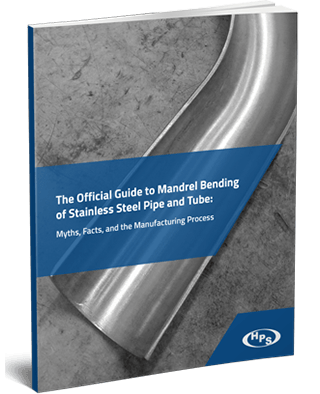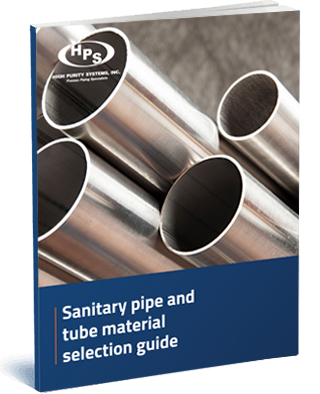What is Mandrel Bending?
Mandrel bending is a method of rotary draw bending, in which – the mandrel, a solid mandrel shaft with up to five segmented, donut shaped, balls that are just slightly smaller than the ID of the pipe/tube that is being bent – is inserted into the pipe/tube to provide internal support during bending. Fitting a mandrel inside of the tube prevents damage such as distortion, collapsing, rippling, and flattening, and gives the technician greater control over the pipe/tube’s ovality or roundness.
This variation of pipe bending is useful for complex jobs requiring tight and large radius bends, multiple radii, high accuracy, and repeatability with minimal deformation. In addition to enhancing project quality, mandrel bending can save over 50% of costs when compared to cutting and welding because it reduces fabrication hours, materials, and weld inspection costs.
Myths & Facts of Mandrel Bending
There are many misconceptions about the perceived risks of mandrel bending stainless steel versus the actual benefits. In reality, mandrel bending is one of the most accurate and cost-effective metal forming processes.
- Myth: Bending is not as strong as welding.
Fact: All pipe fittings are either cast or bent and there is no evidence that one is weaker than the other. In fact, when bent, some materials actually work-harden and become stronger. - Myth: Heat treatment is required after bending for stainless steel pipe and tube bends.
Fact: Austenitic stainless steel belongs in the base metal P-No 8, which is cold bendable per ASME Code without any post-bend heat treatment. - Myth: Bends do not provide a consistent diameter like premade elbows.
Fact: Mandrel bends are held within the same ASME wall thickness and ovality specs to which fitting manufacturers are held. With a mandrel tool supporting the pipe’s interior, technicians actually have more control to make accurate, repeatable bends. - Myth: Bending stainless pipe and tube cannot be completed to accurate angles.
Fact: Bending stainless steel is in fact more accurate than welding it due to weld distortion and weld fit up. Bending with a mandrel tool, especially, prevents pipe damage such as rippling, flattening, and collapsing during the process.
Once end users and manufacturers move beyond the myths of mandrel bending, they can take advantage of the time, material, and cost savings benefits that this metal forming technique provides.
The Manufacturing Process
For large-scale orders, long pipes, complex geometries, or multiple angles, mandrel bending is becoming an increasingly popular fabrication method. Traditional tooling requires a bend die for a specific radius, though modern machines accommodate stackable dies to create parts with multiple bend radii. Some machines allow the bend arm to flip, enabling the creation of symmetrical parts on the same tool.
In addition to managing complex parts with ease, mandrel bending offers a number of advantages over welding, including:
- Time savings —When comparing a welded 90° angle to a pipe bent at the same angle, mandrel bending reduces the number of fabrication hours, as well as the time required to inspect the finished piece. Using CNC-controlled bending machines, manufacturers can save up to 75% of the time it would take to hand-make each weld.
- Cost savings — There can be savings of more than 50% of costs by bending stainless steel instead of welding it, especially due to the tedious visual inspection that certain welding codes require. Upon completion of the welding process, if NDE is required, welds must be x-rayed, costing hundreds of dollars per x-ray. For a pipe with multiple welds, inspection costs add up quickly.
- Material cost and space savings — Not only does bending reduce wasted material because it only requires the original work pieces, but it also saves precious space in your shop as there is no need to store any raw welding material other than the pipe or tube itself.
- Labor savings — By implementing bending technology, onsite labor to install your piping system can be greatly reduced which significantly reduces the risk of safety and / or production issues onsite for the owner/GC.
- Accuracy — Pipe bending facilitates the creation of custom, non-isometric angles and allows engineers enhanced flexibility when constructing complex geometries. The bending equipment creates highly accurate, reproducible results while the mandrel supports the pipe to eliminate distortion. Bending is also more consistent and will reduce any imperfections that are often found in the welding process.
While the nature of mandrel bending lowers costs and delivers high quality, repeatable results, taking extra measures during the ordering process can help to ensure these benefits are achieved. When possible, use common sizes and thicknesses for your tube materials to limit costs and lead times. Selecting a common radius will also save you time and money, as uncommon sizes require custom-built dies which take time to procure.
Is Mandrel Bending of Stainless Steel Pipe and Tubing Right for Your Job?
The following checklist outlines factors that indicate cost savings and value-add opportunities for your business and services. You might reach out to a mandrel bending expert if:
- You have an application that needs full drain-ability where there are no entrapment areas on the ID of the tube or piping system.
- Flow matters – If your pipe or tubing system needs maximum flow with minimal restrictions
- You need the ID of your tubing/piping system to be polished to a certain finish
- Your system requires odd angles that are not offered in standard fittings
- You need consistent quality in your piping systems without the possibility of weld defects
- Your application has requirements of NDE after welding pipe/tube joints which is costly
If your business meets any of the criteria above, you may want to consider a partnership with a mandrel bending expert.
About HPS
With over 30 years of experience, High Purity Systems understands the high stakes of the industries we serve; in many cases, human safety hinges on the precision of a weld and the purity of a system. When working with our customers, we commit to delivering the highest quality service within the strict requirements of your environment.
For more information about how HPS can help you with your next custom pipe bending project, contact our team today.




